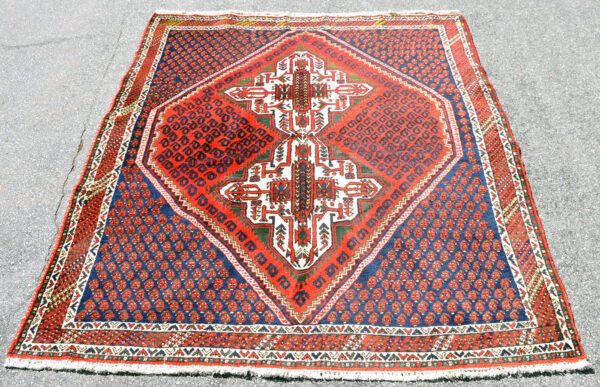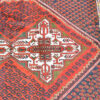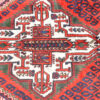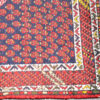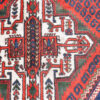Description
Traditional antique tribal Afshari rug from central Iran. This impressive geometric motif is often referred to as a ‘shield’ design.
Very minor wear with generally excellent wool pile. Fringes and side cords are in fine shape with a smidgen of wear on the side cords.
Aside from the predominant reds, whites and blues, the carpet also displays green and yellow.
The rug is woven from natural wool and natural cotton. The field is filled with small icons and blue boteh figures.
Woven in the mid 20th century (1950s – 1960s). The exact size of the carpet is 5 ft. 6 in. by 4 ft. 6 in.
Last photo with silver dollar shows the back. Afshar rugs are often fairly square in shape compared to other tribal rugs that are more rectangular.
A lovely example of a traditional Afshari rug for an appreciative collector.
AFSHARI
The Afshar tribe has a remarkable history, and its weavers create some of the most beautiful village rugs in Iran.
Describing the Afshar, Wikipedia notes:
“The Afshar, also spelled Awshar or Afşar, are one of the Oghuz Turkic peoples. These originally nomadic Oghuz tribes moved from Central Asia and initially settled in Iranian Azerbaijan, later being relocated by the Safavids to Khurasan and Mazandaran. Today, they are variously grouped as a branch of the Turkmens or the Azerbaijanis.
Afshars in Iran remain a largely nomadic group, with tribes in central Anatolia, northern Iran, and Azerbaijan. They were the founders of the Afsharid and Karamanid dynasties. Nader Shah, who became Shah of Iran in 1736, was from the Qirqlu tribe of Afshar.”
The boteh icon, quite common in Persian rugs, has a fascinating history. This pattern, which has also appeared in India, has been popular in Persian carpets for several centuries.
Copied by the British textile industry, the design is often known as Paisley, named after the Scottish town which produced the textiles in mass. The boteh, of course, appeared as a key element in Persian rugs and textiles long before the British borrowed it for their textiles.
The boteh, which can look like leaves, drops of water, little cobras, tadpoles, and many other figures, may date all the way back to ancient Zoroastrianism, over 2500 years ago.
Regarding the origins of the boteh, Wikipedia asserts:
“Some design scholars believe it is the convergence of a stylized floral spray and a cypress tree: a Zoroastrian symbol of life and eternity. Paisley is the quintessential visual metaphor of Iran’s bifurcated and tormented identity – riven between Arabic Islam and pre-Islamic Persian creeds. It is a bent cedar, and the cedar is the tree Zarathustra planted in paradise. The heavenly tree was “bent” under the weight of the Arab invasion and Muslim conquest of Persia. The “bent” cedar is also the sign of strength and resistance but modesty.
According to Azerbaijani historians, the design comes from ancient times of Zoroastrianism and is an expression of the essence of that religion. It subsequently became a decorative element widely used in Azerbaijani culture and architecture.”
Shipping is $34 within continental U.S. Or free pickup in Tucson, Arizona.
Please email me with question. Thank you.
(AS0008 N5)
